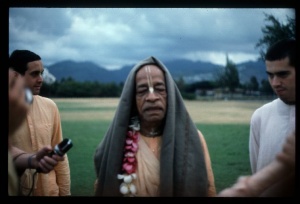CC Adi 13.89 (1975): Difference between revisions
(Vanibot #0027: CCMirror - Mirror CC's 1996 edition to form a basis for 1975) |
(Vanibot #0020: VersionCompareLinker - added a link to the Version Compare feature) |
||
| Line 2: | Line 2: | ||
<div style="float:left">'''[[Sri Caitanya-caritamrta (1975)|Śrī Caitanya-caritāmṛta (1975)]] - [[CC Adi (1975)|Ādi-līlā]] - [[CC Adi 13 (1975)|Chapter 13: The Advent of Lord Śrī Caitanya Mahāprabhu]]'''</div> | <div style="float:left">'''[[Sri Caitanya-caritamrta (1975)|Śrī Caitanya-caritāmṛta (1975)]] - [[CC Adi (1975)|Ādi-līlā]] - [[CC Adi 13 (1975)|Chapter 13: The Advent of Lord Śrī Caitanya Mahāprabhu]]'''</div> | ||
<div style="float:right">[[File:Go-previous.png|link=CC Adi 13.88 (1975)|Ādi-līlā 13.88]] '''[[CC Adi 13.88 (1975)|Ādi-līlā 13.88]] - [[CC Adi 13.90 (1975)|Ādi-līlā 13.90]]''' [[File:Go-next.png|link=CC Adi 13.90 (1975)|Ādi-līlā 13.90]]</div> | <div style="float:right">[[File:Go-previous.png|link=CC Adi 13.88 (1975)|Ādi-līlā 13.88]] '''[[CC Adi 13.88 (1975)|Ādi-līlā 13.88]] - [[CC Adi 13.90 (1975)|Ādi-līlā 13.90]]''' [[File:Go-next.png|link=CC Adi 13.90 (1975)|Ādi-līlā 13.90]]</div> | ||
{{CompareVersions|CC|Adi 13.89|CC 1975|CC 1996}} | |||
{{RandomImage}} | {{RandomImage}} | ||
==== TEXT 89 ==== | ==== TEXT 89 ==== | ||
| Line 18: | Line 17: | ||
<div class="synonyms"> | <div class="synonyms"> | ||
caudda-śata sāta-śake—in 1407 of the Śaka Era (A.D. 1486); māsa—month; ye—which; | caudda-śata sāta-śake—in 1407 of the Śaka Era (A.D. 1486); māsa—month; ye—which; phālguna—of the name Phālguna; paurṇamāsira—of the full moon; sandhyā-kāle—in the evening; haile—there was; śubha-kṣaṇa—an auspicious constellation. | ||
</div> | </div> | ||
| Line 25: | Line 24: | ||
<div class="translation"> | <div class="translation"> | ||
Thus in the year 1407 of the Śaka Era | Thus in the year 1407 of the Śaka Era (A.D. 1486), in the month of Phālguna [March-April], on the evening of the full moon, the desired auspicious moment appeared. | ||
</div> | </div> | ||
| Line 34: | Line 33: | ||
Śrīla Bhaktivinoda Ṭhākura, in his Amṛta-pravāha-bhāṣya, has presented the horoscope of Śrī Caitanya Mahāprabhu as follows: | Śrīla Bhaktivinoda Ṭhākura, in his Amṛta-pravāha-bhāṣya, has presented the horoscope of Śrī Caitanya Mahāprabhu as follows: | ||
śala 140710222845 | |||
dinam | |||
7 11 8 | |||
15 54 38 | |||
40 37 40 | |||
13 6 23 | |||
The explanation of the horoscope given by Bhaktivinoda Ṭhākura is that at the time of the birth of Lord Caitanya Mahāprabhu the | The explanation of the horoscope given by Bhaktivinoda Ṭhākura is that at the time of the birth of Lord Caitanya Mahāprabhu the constellations were situated as follows: Śukra (Venus) was in Meṣa-rāśi (Aries), in the constellation of Aśvinī; Ketu (the ninth planet) was in Siṁha-rāśi (Leo), in Uttaraphalgunī; Candra (the moon) was in Siṁha-rāśi, in Pūrvaphalgunī (the eleventh lunar mansion); Śani (Saturn) was in Vṛścika-rāśi (Scorpio), in Jyeṣṭhā; Bṛhaspati (Jupiter) was in Dhanu-rāśi, in Pūrvāṣāḍhā (Sagittarius); Maṅgala (Mars) was in Makara-rāśi (Capricorn), in Śravaṇā; Ravi (the sun) and Rāhu were in Kumbha-rāśi (Aquarius), in Pūrvabhādrapāda; and Budha (Mercury) was in Mīna-rāśi (Pisces), in Uttarabhādrapāda.. The lagna was Siṁha. | ||
</div> | </div> | ||
Latest revision as of 15:13, 26 January 2020

A.C. Bhaktivedanta Swami Prabhupada
TEXT 89
- caudda-śata sāta-śake māsa ye phālguna
- paurṇamāsīra sandhyā-kāle haile śubha-kṣaṇa
SYNONYMS
caudda-śata sāta-śake—in 1407 of the Śaka Era (A.D. 1486); māsa—month; ye—which; phālguna—of the name Phālguna; paurṇamāsira—of the full moon; sandhyā-kāle—in the evening; haile—there was; śubha-kṣaṇa—an auspicious constellation.
TRANSLATION
Thus in the year 1407 of the Śaka Era (A.D. 1486), in the month of Phālguna [March-April], on the evening of the full moon, the desired auspicious moment appeared.
PURPORT
Śrīla Bhaktivinoda Ṭhākura, in his Amṛta-pravāha-bhāṣya, has presented the horoscope of Śrī Caitanya Mahāprabhu as follows:
śala 140710222845
dinam
7 11 8
15 54 38
40 37 40
13 6 23
The explanation of the horoscope given by Bhaktivinoda Ṭhākura is that at the time of the birth of Lord Caitanya Mahāprabhu the constellations were situated as follows: Śukra (Venus) was in Meṣa-rāśi (Aries), in the constellation of Aśvinī; Ketu (the ninth planet) was in Siṁha-rāśi (Leo), in Uttaraphalgunī; Candra (the moon) was in Siṁha-rāśi, in Pūrvaphalgunī (the eleventh lunar mansion); Śani (Saturn) was in Vṛścika-rāśi (Scorpio), in Jyeṣṭhā; Bṛhaspati (Jupiter) was in Dhanu-rāśi, in Pūrvāṣāḍhā (Sagittarius); Maṅgala (Mars) was in Makara-rāśi (Capricorn), in Śravaṇā; Ravi (the sun) and Rāhu were in Kumbha-rāśi (Aquarius), in Pūrvabhādrapāda; and Budha (Mercury) was in Mīna-rāśi (Pisces), in Uttarabhādrapāda.. The lagna was Siṁha.